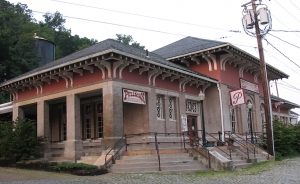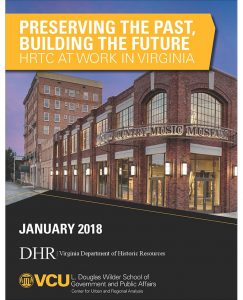Upper Story Residential Development- Tech Sheet
/in Blog/by Frazier AssociatesHistoric downtowns offer a variety of building types from typical commercial buildings to government buildings such as city halls and courthouses, as well as churches, banks, theaters, warehouses, and industrial buildings. With downtowns large and small reemerging as the heart of a community, where one can experience entertainment, dining, and shopping, it makes sense that […]
Twenty-four Reasons Historic Preservation is Good for Your Community
/in Blog/by Frazier Associates Over the last five years PlaceEconomics has done analyses of the impacts of historic preservation in nearly a dozen cities of all sizes throughout the United States. From that research they have assembled the twenty-four reasons why historic preservation is good for your city. This impressive list includes facts on how preservation benefits your community, from livability and housing to growing businesses and strengthened property values. Virginia’s Main Streets, including Staunton, are a great example.Thank you to PlaceEconomics and Donavan Rypkema, principal for presenting, Twenty-four Reasons Historic Preservation is Good for Your Community; a straight-forward list of inspiring and stories for historic preservation. 24 Reasons HP Good For Communities-1
Over the last five years PlaceEconomics has done analyses of the impacts of historic preservation in nearly a dozen cities of all sizes throughout the United States. From that research they have assembled the twenty-four reasons why historic preservation is good for your city. This impressive list includes facts on how preservation benefits your community, from livability and housing to growing businesses and strengthened property values. Virginia’s Main Streets, including Staunton, are a great example.Thank you to PlaceEconomics and Donavan Rypkema, principal for presenting, Twenty-four Reasons Historic Preservation is Good for Your Community; a straight-forward list of inspiring and stories for historic preservation. 24 Reasons HP Good For Communities-1
Staunton Preservationist, Vic Meinert
/in Blog/by Frazier AssociatesStaunton has been very fortunate over the past 40 some years to have individuals dedicated to preserving and revitalizing its historic resources. One of those key individuals was Vic Meinert. While the historic rehabilitation movement had taken hold in Staunton by the 1980s and the City was experiencing investment in both downtown and its surrounding historic neighborhoods, a number of prominent buildings were still waiting on the right person to come along.
Vic became that person and raised the bar on historic preservation with his accurate and beautiful rehabilitations of the landmark Marquis Building at the corner of Beverley and Augusta Streets and the C&O Train Station in Staunton’s Wharf Historic District.
“He was just an incredibly passionate man about historic preservation,” Bill Frazier said. “He was a very hard worker. He was driven to fix up that train station.” Read more about Vic’s rehabilitation and dedication to downtown in this article from the Staunton News Leader, July 3, 2019.
We are thankful for Vic’s passion for Staunton’s historic architecture and offer our sympathies to his family.

The C&O Train Station following extensive rehabilitation by Vic Meinert.
Eleven Questions to Ask an Architect- shared from Houzz
/in Blog/by Frazier AssociatesThis article, “11 Questions to Ask and Architect”, from the popular home ideas website, Houzz, has some helpful advice for consulting with an architect. From what to ask about fees and budgeting, to how to bring in a contractor, these are good talking points for beginning a conversation with an architect. Frazier Associates welcomes questions and enjoys talking with potential clients about the process of working with an architect and designing your new or rehabilitated home. Feel free to check out our Residential Design page or contact us for more information on how we can start a conversation about your potential project!
Loft Project Featured on HGTV Website
/in Blog/by Frazier Associates
Photo by Mark Miller
Frazier Associates’ design for the conversion of a small historic garage building into a urban loft is featured on the HGTV (Home and Garden TV network) website. The design transformed a 1910 commercial garage into a small, but creative and efficient 1,260 square foot home in Staunton’s historic downtown. The aesthetic focused on the exposed brick walls and concrete floors of the former garage, and incorporated new elements such as a new staircase with a sleek metal railing and a new recessed “storefront style” entrance behind the original garage door that creates a small outdoor patio. See the full project description and photos in our Residential Design Urban Lofts section.
Historic Rehabilitation Tax Credit Study
/in Blog/by Frazier Associates The Virginia Department of Historic Resources (VDHR) recently commissioned an intensive study of the economic impact of the state historic tax credit. The study, “PRESERVING THE PAST, BUILDING THE FUTURE: HRTC AT WORK IN VIRGINIA” was undertaken on behalf of the Department by the L. Douglas Wilder School of Government and Public Affairs at Virginia Commonwealth University. The full study can be found at https://www.dhr.virginia.gov/pdf_files/DHR%20HRTC%20Report.pdf
The Virginia Department of Historic Resources (VDHR) recently commissioned an intensive study of the economic impact of the state historic tax credit. The study, “PRESERVING THE PAST, BUILDING THE FUTURE: HRTC AT WORK IN VIRGINIA” was undertaken on behalf of the Department by the L. Douglas Wilder School of Government and Public Affairs at Virginia Commonwealth University. The full study can be found at https://www.dhr.virginia.gov/pdf_files/DHR%20HRTC%20Report.pdf
Frazier Associates is proud to have worked on many historic tax credit projects throughout Virginia over the past 31 years resulting in millions of dollars of investment and improved buildings in our downtowns. Our historic architects and staff have a vast amount of experience designing for the tax credit process and completing the three-part application process for property owners. All of our designs reflect The Secretary of the Interior’s Standards for Rehabilitation, which must be met to take advantage of these incentives. As the study points out, these rehabilitation projects contribute greatly to the economy of our communities long after they are completed “by making available commercial and residential square footage in historic districts that was previously unused or underutilized. These projects act as catalysts to attract businesses and residents in historic downtowns.” Read more about some of our tax credit projects or contact us to see how we can help explore using this incentive on your commercial or residential rehabilitation project.
Community Wayfinding Sign Manual-VDOT 2017
/in Blog/by Frazier Associates The Virginia Department of Transportation (VDOT) recently published and adopted a Community Wayfinding Sign Manual that provides a consistent statewide policy and outlines step-by step procedures for localities to gain VDOT approval for developing and implementing, wayfinding sign systems. The manual addresses design, locations, spacing, legibility, and safety factors for communities and designers to follow in creating signs. It delineates specific procedures for sign program development and planning, as well as construction and maintenance.
The Virginia Department of Transportation (VDOT) recently published and adopted a Community Wayfinding Sign Manual that provides a consistent statewide policy and outlines step-by step procedures for localities to gain VDOT approval for developing and implementing, wayfinding sign systems. The manual addresses design, locations, spacing, legibility, and safety factors for communities and designers to follow in creating signs. It delineates specific procedures for sign program development and planning, as well as construction and maintenance.
As stated in the manual, “Virginia is rich in historic, cultural, and recreational destinations and communities are increasingly recognizing the economic benefits of marketing to the public through specialty directional signing. Wayfinding programs are considered an integral part of promoting tourism and competing for the economic benefits. A well-crafted wayfinding sign system provides an opportunity to educate and inspire the traveling public and promote visitation to some of Virginia’s great destinations.”
In developing the Sign Manual, VDOT collaborated with The Federal Highway Administration, Virginia Municipal League, Virginia Association of Counties, Virginia Tourism Corporation, various counties and cities, and numerous individuals, including Kathy Frazier, AIA and Sandra Hanger, SEGD, of Frazier Associates. Several test pilot wayfinding programs were used to help determine the process and requirements for the manual. Among those were three of Frazier Associates’ wayfinding projects, including the Historic Triangle in Williamsburg, James City County and York County, which was the state’s first regional wayfinding system. Stafford County; Rockbridge County; and Gordonsville followed this. Frazier Associates is pleased to have worked with VDOT representatives, particularly Rick Burgess of the Central Office Traffic Engineering Division, on these test studies to streamline the process for communities to implement wayfinding systems across the state.
Click here to read more about Frazier Associates wayfinding services.












